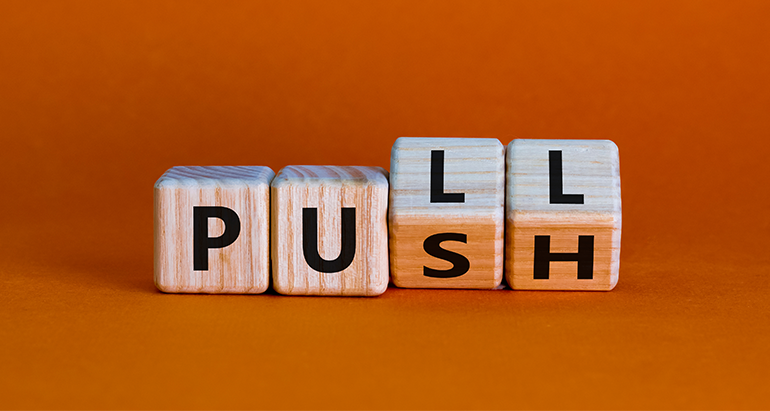
Push vs. Pull Marketing: What's Right For You?
By Lindsay Valenty -
Today, there are so many ways digital marketers can build their audience.
The myriad of ways come down to two choices: push plans or pull strategies. But what does that mean?
Push Vs. Pull Marketing
Push Marketing
As the name implies, push marketing involves—you guessed it—pushing your message in front of your audience. Banner ads are an example of this type of marketing.
Pull Marketing
More commonly known as inbound marketing, pull marketing showcases solutions you offer to existing or emerging problems.
Digital channels are an excellent avenue for this type of marketing. Using different targeting tactics, you can target your consumers during every stage of their lifecycle journey.
We'll now go through how push and pull marketing differs in each lifecycle stage.
Push and Pull Strategies for Each Lifecycle Stage
Awareness
The awareness phase is the very essence of push marketing. You have a new product or service to offer, and you need to spread the word to make consumers aware of what you offer. Building awareness is building buzz.
Push: Spread the word about your brand to new audiences through paid advertising, display marketing, direct mail, and pay-per-click.
Pull: Develop blog content for individuals at the earliest stages of their buying process. It's a prime time for you to make sure their search leads them to discover your brand as a solution provider.
Engagement
The engagement phase motivates consumers to interact with your brand, whether on social media, through a newsletter, or IRL. Create a community around your company by starting and moderating the conversation.
Push: Broadcast your content through SMS updates, RSS feeds, or email subscriptions. These methods send notifications directly to your end-user to prompt engagement.
Pull: Publish high-quality, downloadable content on your website and promote it through your social media channels. Sharing your content allows people to find, like, and forward it to people they think would benefit from it.
Conversion
During this critical stage of your customer lifecycle, consumers are ripe for the picking—actively seeking solutions with the intent to purchase. The conversion stage is when to provide content that makes a case for your brand or incentives to lower the perceived risk of purchase.
Push: Retargeting methods work best to get consumers to close on that product or service you're promoting. Strategies could include direct mail, digital ads, or email drip campaigns.
Pull: A timely email coupon may be the final incentive a consumer on the fence needs to act. Or perhaps your SEO strategy attracts a shopper who is ready to make a purchase but hasn't discovered your brand yet.
Retention
Previous customers are your best source of repeat business and brand ambassadorship.
Ways to help them spread the word and keep coming back include:
• providing an excellent customer service experience
• creating and sharing high-quality content
• continually offering incentives to valued customers—discounts, exclusive products, etc.
Retention is about building long-term relationships and customer loyalty.
Push:
• Use traditional outbound channels to share incentives for repeat business.
• Loyalty programs, volume discounts, and referral offers are all tried and true methods for developing long-term retention and repeat business.
Pull:
• Forge solid and lasting relationships with your current audience of converted customers.
• Deliver the content, resources, and products that reaffirm your value and build long-term trust.
• Make it easy for your audience to find and share these resources through SEO, active social media channels, and an email newsletter.
As your business grows, you'll naturally start focusing your efforts on primarily pull marketing methods.
Inbound tactics result in a 60-62% lower cost per lead than push marketing methods. SEO leads have nearly an 8x higher conversion rate than outbound ("push") leads. Essentially, you spend less and earn more—dream come true, right?
Of course, it takes time to build up the authority and brand awareness for pull marketing methods to reach their optimal effectiveness. You should start early and start smart in building your SEO strategy.
Our digital strategy starts with targeted SEO research and elegant, functional web design—and follows through with data-driven email marketing, digital ads, social media and more. Let's get digital.